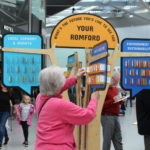Co-design & Resilience
Catherine Greig
‘Does co-design build resilience’ ? is something that we have been thinking about a lot recently as we think in more detail about the extent of co-design on our projects.
First of all, let’s talk about co-design; as a term, it can be quite divisive with finger-pointing all round at those who claim to be doing it but aren’t actually in practice working authentically with a co-design approach. This is why we do not use that word that much but we do often talk about the range of ways that co-design or co-creation manifests itself in our projects; if we are commissioned to co-create a playground structure we can do just that on the design itself but somebody has already determined the need before inviting people (and us) to be involved. There is also the case where we co-create artwork which is applied to existing or new structures, we then have to be clear about the constraints of what can or can’t be done in budget and timeframe before starting the co-create process; people are involved but blank canvas it is not. Finally, we work on brief setting co-creation projects where we working with people from the outset to set the direction of travel but then another design picks this up and delivers on it and there is no way of ensuring that local involvement continues in a meaningful way if we are not involved. This is the conundrum – if resilience can be fostered by being involved in your local area, seeing how your voice has had influence is crucial but how much influence is enough and at what point is it simply no longer meaningful.
For us, it is about being clear about where people can have influence and maximising their leverage over this influence. At the beginning of make:good I used to talk about people being involved in change building their resilience to it and now, hundreds of projects down the line, I think it is much more complicated than that. It depends how people are involved, in what level of detail and whether the involvement is based around them being able to leverage their influence to shape the change they want to see or whether they are involved but the outcome is still something they don’t feel in any way connected to. This can be equally true of co-design; people can attend workshops, draw things, model things but the end result can feel either representative of their input or void of their input. The first builds a sense of agency as you realise you have a voice and can impact things and this helps build resilience as you become aware that you can change things around you. The other just confirms a sense of powerlessness, that you can not change things around you and even when people ask they do not really want to know the answer. So it all comes back to the intention behind the project which is why we often say no to work where we think that influence is minimised and the involvement will be in name only.
Here are some different ways that we have used co-creation, participation and engagement to shape neighbourhood change to evidence agency which in turn, we think, can help build resilience in places.
Brick Lane
A place of eternal change but currently a place, a little like Brixton, that is often highlighted as being representative of gentrification – pushing out and marginalising existing communities to make room for hip commercialism. On the surface it may seem like a resilient place but as is the case with most of London it is a place of inequality where people with access to different levels of resources live side by side. The brief was this project was set before it came to us but we devised a way to work with local schools to create artwork for lamp columns along the stretch of Brick Lane which would reflect the diversity and heritage of the area. The final pieces can resonate with visitors and locals alike but have provided a lovely way that communities that can feel silenced have a visual presence in the area.
Dagenham Mindfulness Structures
We used hands-on creative workshops with children to design two mindfulness structures in a school playground; we love thinking about how we can foster a sense of agency in children so that they learn early on that there opinion matters. The context of school grounds meant we could be much freer in how we approached the work but the number of children involved meant that there had to be compromise in terms how we incorporated people’s ideas. We had to filter through the design ideas, pull together the common themes and then refine the ideas into something that reflected as much input as possible but still appeared like a coherent (and calm) space. Ultimately these projects provided the opportunity for children to see something they had designed realised.
Romford Town Centre Masterplan
This project was about setting a vision for a place and understanding the ingredients that people wanted to see included in their future town centre. It was not about a set project that would be taken from design through to completion but about setting guiding principles for what/ how future development should take place. Whilst the outcomes are harder to immediately visualise and realise there is something so powerful about being involved in shaping how the places you are most connected to will evolve. As the plan is implemented over time people will, we hope, begin to have the same sense of ‘I helped make this happen’ as the more immediately tangible projects we have worked on foster.










